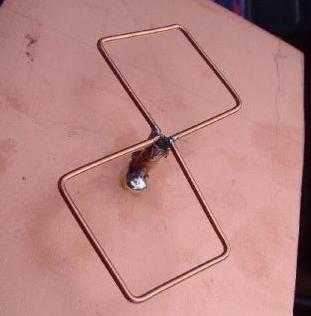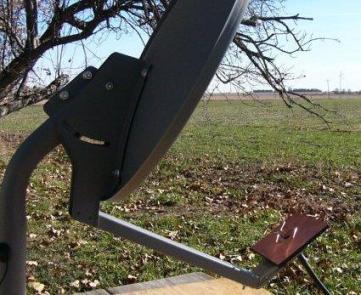
How-to Access GB3KM..
Here we have a basic guide on getting started with ATV through GB3KM, It shows the main things that need to be looked at when starting out.
For simplicity it describes using 2.4GHz equipment but most of the information applies to the other bands too.
Please don't be put off by the cost of equipment, it's quite reasonable when you think of how much you usually pay for a HF transceiver! And you may have half of the equipment already..
Don't hesitate to give one of the local stations a call on 144.750MHz (the 2m ATV talkback frequency)
The Basics..
The basic parts of an ATV station are very much the same as for any other band, but with a couple of extra's that you probably already have.
1: An Antenna - usually some sort of Yagi or Dish for ATV frequencies as they are in the GHz bands, have you an old satellite dish laying in the shed?
2: Coax - higher spec coax is usually needed on ATV due to the high frequencies, Westflex-103 is common but there is better..
3: Transceiver - usually one unit but in ATV is usually two separate units with a changeover switch
4: A Monitor - any Television with a Scart/AV input will do
5: A Camera - Do you have a camcorder? They usually have Audio/Video output socket which will plug straight into an ATV transmitter!)

Where to Start..
The first thing you need to consider when thinking about getting on 'KM is to check the coverage maps to see if you are within the coverage of the repeater
If the map shows marginal coverage for your location then it is possible for us to do a specific path plot to give a little more detailed prediction of reception, the coverage map is not always 100% correct!
If you are within coverage then the best thing to do is to buy a receiver or borrow one from one of the local stations (we usually have some spares!) the antenna required will depend on the path to the repeater, A simple home made bow-tie antenna on it's own for good predicted paths, a small dish with bow-tie feed for lower signal paths, some Wi-Fi antennas work reasonably well for 13cm too. Remember all ATV transmissions are Horizontally polarised!
Ideally the path to the repeater will need to be reasonably clear of trees/buildings.
A Simple antenna for 13cm - the Bi-Quad (bow-tie) antenna, it can be used as a satellite dish feed too where an LNB would normally go.


How to build one..
http://koti.mbnet.fi/zakifani/biquad/
http://www.wlan.org.uk/simple_double_quad.gif
http://www.engadget.com/2005/11/15/how-to-build-a-wifi-biquad-dish-antenna/
Comtech modules - I'm sure you have heard these mentioned in other atv pages.. The 'comtech' modules are actually demo boards from Comtech that have become available and made ATV on 13 & 23cm quite cheap to get into,they are not renound for quality but a good way to get on ATV.
13cm Comtech Receivers are available here 13cm.co.uk and MobiComm
A converted LNB for 10GHz would cost under £25, old satellite LNB's can be modified (some already modified are available to KM users) with this method an old analogue satellite receiver would also be needed.
Receiving a signal..
With your receive equipment you will need to check whether it's possible to receive a signal from the repeater, the strength of the signal you get will give an idea of what Tx equipment will be required later on.
With your antenna you may need to think of where it will be positioned if you decide to make a permanent installation, on the microwave bands small changes of antenna position can make a huge difference to the signal strength. Your test antenna will need to be positioned somewhere at the side of the house facing the repeater - ATV signals will not travel through brick walls quite like they do on lower bands! It may be possible to test from your loft space pointing through the tiles or an OPEN window. Some new glass absorbs microwave signals very well!
For testing you can just use a small antenna connected straight onto the receiver and use some longer AV/Power leads to connect the receiver to the monitor so you are able to point the antenna around.
If the antenna has to be some distance fro the receiver then either some low loss coax will be required or you can use even longer AV and Power leads back to the monitor and leave the receiver at the antenna - this is recommended due to the high loss through coax at these frequencies.
Now once you have setup the receiver make sure that you are tuned into the repeater frequency - 2.440GHz (2440MHz) and make sure you see noise 'snow' on the monitor, some monitors block weak signals with a blue screen, if this is the case it is advisable to test with another monitor because it is near impossible to look for weak signals like this.
If you don't receive anything straight away don't be put off, try various positions for the antenna as it does make a big difference, height and obstructions have the most effect on signals.
If you receive a reasonable signal with your test setup then it should be quite easy to get a working system on ATV with a slightly better antenna. If you are still having problems, please call on 144.750MHz or contact us for some help!
If the repeater signal is received at P5 easily then a basic 200mW transmitter will probably suffice (on 13cm), also if this is the case then 10GHz receive is preferable but not necessary.
If it is below P5 then an antenna with more gain maybe required, from tests using GB3KM we have found that dish antennas on 13cm seem to give the best performance and are usually free..
P-Grade - the measure of ATV signal strength
P1=Very weak, can't resolve picture
P2=Weak but faint picture visible
P3=Noisy picture possibly with colour
P4=Good colour picture
P5=Excellent picture with no noise
Transmitting..
So if you have got this far and have managed to get a good signal from the repeater and you want to access then you will need some Tx equipment.
Input to the repeater is available on 23cm,13cm and 3cm bands, the most easily available equipment is on 13cm and is what most of the users have.
You have the option of duplex where you can receive the repeater while transmitting or simplex where you take turns transmitting to the repeater, it is a good idea to aim to do duplex as that is what the repeater is designed for but simplex works fine too. See below for more information.
If you have a temporary antenna installed for receive then this will do for TX tests too. The TX can also be located at the antenna just like the RX by using up to 10M long AV and Power leads.
So far on KM most users have used two antennas to begin with, one for receive and one for transmit so a antenna switch is not required and so that duplex operation is possible.
For example Eddie, G0EHV uses a small panel antenna on the side of his house for receive and a dish in the loft for transmit, this enables easy duplex operation. Eddie's Setup below:
If you are going to use a separate antenna for Tx then the best bet is to install it and then connect the receiver up to it to optimise the received strength from the repeater, then you know it is lined up correctly for Tx.
A 13cm 'comtech' Transmitter with 10mW output is about £50, 1W amplifiers are available for around £35 (WiFi boosters), 25W amplifiers are available for about £100
A 23cm 'comtech' transmitter with about 50mW output is about £50, An amplifier would be needed with this transmitter - 1W would cost about £35, 20W would cost about £100
See 13cm.co.uk and MobiComm for prices
A 3cm transmitter is a bit more complicated, new kit is very costly but old satellite LNB's can be modified into transmitters at low cost, not advisable for beginners but there are good guides on the web of how this is done if you fancy a go!
IK8UIF LNB TX Mods Blue cap LNB TX Mods
So, once you have your transmitter connected up and ready, make sure you are tuned to one of the input frequencies of the repeater - 1280MHz, 2328MHz or 2388MHz. Once running you may have to alter these frequencies very slightly to optimise the signal into the repeater.
Access to the repeater will only happen if you have a video signal connected to your transmitter, make sure you have a camera or other video source connected and that it is switched on!
If you are attempting duplex operation you will most likely be able to see if you are accessing the repeater by looking at the receiver but if not then it is possible to monitor the repeater via the internet webstream to check you signal quality, you could also call on 144.750 to confirm with another station that you're accessing ok.
Remember the webstream can be many seconds delayed from real life!
Simplex/Duplex Operation
GB3KM is designed to be a duplex repeater having multiple inputs for up to four users at any one time, simplex operation is still possible just like any other repeater.
Simplex operation is just like using 2m for a chat, each person takes it in turns to have their 'over'
Duplex operation is real time chat where both stations can talk and hear at the same time. It's just as if the other station is in the shack with you, and in a way actually is - on the screen!
Simplex operation only needs one antenna on 13cm, the most basic setup.
Duplex operation usually involves two antennas on different bands, one connected to the receiver (for example a 13cm antenna) and one connected to the transmitter (for example a 23cm antenna)
Using duplex on the same amateur band is more difficult due to the de-sensing of the receiver by the transmitter signal. It is possible to use well spaced antennas to do this or to use a filter in line with the receiver that blocks the transmitter signal. Duplexers can also be used so that only one antenna is required for transmit and receive simultaneously - Some of these for 13cm are available to 'KM users on request.
Coax/Connector Information
SMA Connectors are the main type of connector used on low power equipment for 1.2GHz up over, they look like this:


N-Type Connectors are used on most low loss coax cable at this frequency and larger antennas normally have N Sockets to connect to, they look like this:


It is likely that you will need to adapt from N to SMA at some point and this can be done with a N-SMA adaptor. This is ok as long as you do not put much strain on the connectors from the large N connector with it's heavy coax, then it's better to use a small N-SMA patch lead. See below


Ideally you should use the lowest loss coax possible between the TX/RX and the antenna. Don't think about using RG-58 coax, it's useless at 2.4GHz!
For short connections RG-223,RG316 is ok for up to a foot or two, longer connections should be Westflex-103 or one of the types of Ecoflex cables.
Diode communications sells Ecoflex-10 cable and Westflex is available at the usual suppliers.
Remember Westflex does not fit into conventional N connectors as the centre conductor is larger. It is possible to file it down to fit but special N connectors for westflex available.
This page is still under construction - please visit again for updates!